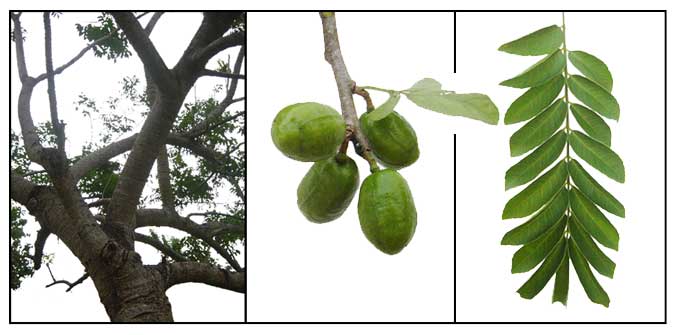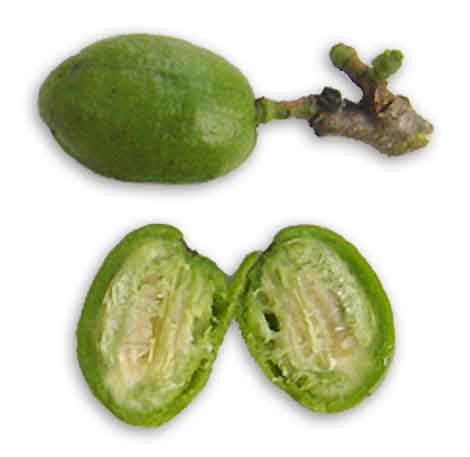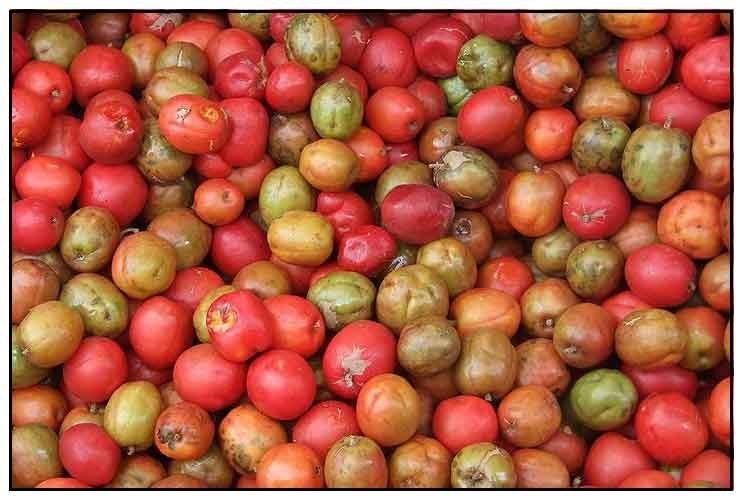
Gen info
-
Spondias purpura is a species of flowering plant in the cashew family, Anacardiaceae. It is native to the tropical regions of the Americas, from Mexico to northern Columbia and the southwest Caribbean Islands.
- The genus Spondias consists of 17 described species, 7 are native to the Neotropics, and about 19 to tropical Asia.
- Etymology: It is commonly known as 'jocote', which derives from the Nahuatl word xocotl, meaning any kind of sour or acidic fruit. (24)
Botany
Sineguelas is a deciduous tree
growing to a height of 5 meters. Trunk is stout, with thick spreading
branches. Leaves are pinnate, 15 to 25 centimeters long. Leaflets occur
in 5 to 9 pairs, oblong-ovate, 5 to 7 centimeters long. Flowers are solitary
or fascicled in the axils of the fallen leaves, reddish, and
3 to 3.5 millimeters long. Fruit is smooth and thin-skinned, oblong or subglobose,
about 2.5 centimeters long, with a fleshy pericarp, yellowish green or
dark-purplish outside, with a large and stony seed. When ripe,
the seed is surrounded by a soft, sweet, and aromatic juicy pulp.
Distribution
- Introduced from tropical America by the Spaniards during the colonial era.
-
Cultivated for
its edible fruit throughout the Philippines.
- Now pantropic; naturalized throughout the tropics all over the world.
 Constituents Constituents
- Mineral content and food values are: Moisture 75.6 - 85.44%, ash 0.57-0.9%, phosphorus 0.11%, calcium 0.01%, iron 0.003%, proteins 0.63%, fats 0.09%, carbohydrates 21.16%, crude fiber 0.62%.
- Study of amino acid composition of the gum yielded
hydroxyproline (main AA), aspartic acid, glutamic acid, serine, proline, threonine, and alanine.
- Peels of jocote fruits yielded phenolic acids and several flavonol O-glycosides of quercetin, kaempferol, kaempferide and rhamnetin.
(8)
- Crude peel extracts yielded phenolic and flavonoid contents of 28.68 ± 0.046 mg GAE/g and 2.64 ± 0.005 mg EQ/g extract, respectively.
(see study below) (26)
Properties
- Fruit is astringent; considered diuretic and antispasmodic.
- Shoots are astringent.
- Seeds considered toxic.
- Studies have suggested antimicrobial, antioxidant, non-mutagenic, anxiolytic, antinociceptive, anxiolytic, antifertility, lipid lowering, hematinic, nutrient, anti-inflammatory, cytoprotective, antiulcer, photoprotective properties.
Parts
utilized
Bark, fruit, leaves.
Uses
Edibility
• Fruit has a thin skin and a large seed, surrounded by a soft, sweet, aromatic, and juicy pulp when fully ripe.
Although much eaten, it is not considered a high-quality fruit, with a tendency to cause stomachaches when eaten semi-ripe in large quantities.
• Also used as seasoning for sweets and pickling.
• In the Ecuadorian coastal plain
and Andes, processed into marmalade, wine,
liquor.
 Folkloric Folkloric
• Decoction of the bark
used for dysentery and infantile tympanites.
• Sap of the bark is applied to the infants mouth for stomatitis (dapulak).
• Fruit is astringent and useful in diarrhea.
• In Brazil, decoction of bark used
for diarrhea; decoction of flowers and leaves used for constipation
and stomach aches. Decoction of the fruit used for diarrhea, dysentery, gonorrhea.
• The Tikunas Indians of the Amazon
use the decoction of bark for pain and excessive menstrual bleeding,
for stomach pains and diarrhea, and for washing wounds.
• Cubans used the fruit as emetic.
• Dominicans use it as laxative.
• Bark used for minor skin ulcers.
• In Haiti, leaf juice taken orally for swollen glands and trauma. Crushed leaves applied for headaches. Fruit consumed in large amounts for constipation. Also used for diarrhea and dysentery. Fruit syrup used for angina.
• Fruit decoction used to bathe wounds.
• Juice of fresh leaves used for thrush.
• Decoction of leaves and bark used as febrifuge.
• Crushed leaves applied as head bath for headaches.
• In the Guianas fruit used as ingredient in marmalade laxative; shoots as astringent.
• In Nigeria, infusion of shredded
leaves used to wash wounds, cuts, sores and burns.
• In Jamaica, leaves are boiled to make a cold remedy; also used for sore gums, diarrhea and dysentery. In Maya medicine, plant used to make baths for skin diseases.
• Resin of tree used with pineapple and soursop for jaundice.
• Amazonian Indians use a daily cup
of decoction for permanent sterility.
• In Peru, leaf and bark decoctions used to aid delivery.
• In Guatemala, leaves used for diarrhea and dysentery.
Others
• Stains: Fruit used to
remove stains from clothing and for washing hands.
• In French Guiana, shoots are considered
astringent. Fruit used as ingredient in laxative marmalade. Seeds considered
toxic.
• Veterinary: In Eastern Nigeria, fresh leaves of S. mombin used to aid delivery and expel the placenta
in small ruminants.
Studies
• Many compilations list Spondias purpurea (sineguelas) and Spondias mombin (hevi) separately; some compilations list them as synonyms. There is also an overlap for synonyms and common names on both species. Red mombin is applied to Spondias purpurea and yellow mombin to Spondias mombin.
• Until resolved, I have included the studies for Spondias mombin.
• No Antimicrobial Activity / Bark Sap: Study evaluated the antimicrobial properties of sineguelas bark sap against bacterium E. coli and fungus Trichoderma reesei. The bark sap was not effective in inhibiting the growth of both test organisms. (1)
• Antimicrobial / Anti-Enterobacterial: In a study of 84 plants screened for in vitro activity against five enterobacterial pathogenic to man, Spondias purpurea was one of ten plants that showed the best antibacterial activity and provides scientific basis for use in enterobacterial infections in man.
(2)
• Polysaccharide Gum: Study of S. purpurea var. lutea polysaccharide gum yielded 3-O- and 6-O-galactosyl residues, terminal and 3-O-α-l-arabinofuranosyl, terminal rhamnosyl residues and ironic acids, represented by β-d-glucuronic acid and its 4-O-methyl derivative.
(6)
• Gum / Pharmaceutical Binding: Study showed the S. purpurea
bark gum has binding abilities which can be employed when high mechanical strength and fast to moderate release is required. (7)
• Antioxidant / Pharmaceutical Binding: Study evaluated five tropical Brazilian fruits for antioxidant activity using four different assays. All results showed high antioxidant properties for siriguelas (S. purpurea).(9)
• No Mutagenic Potential: Study evaluated the mutagenic potential of S. purpurea through the micronucleus test in peripheral blood of mice in vivo. Results showed no mutagenicity.
(10)
• Antinociceptive Activity / Leaves: Study evaluated the in vivo effects of leaf extracts of S. mombin on reproductive performance of female rats.
Results showed antinociceptive activity, but no abortifacient or estrogenic activity. (12)
• Anxiolytic Activity: Study evaluated the anxiolytic properties of various extracts of Spondias mombin leaves using aggressive behavior response and depression-related swimming behavior activities.
All test extracts abolished aggressive attacks in rats and reduced swimming time in mice. Results suggest an anxiolytic effect mediated by GABAergic transmission.(13)
• Male Antifertility Effect / Leaves: Study evaluated an ethanol extract of Spondias mombin leaf on male rats for antifertility effect. There were histomorphological changes in the testis with significant reduction of serum testosterone. Results suggest potential sterility through suppression of spermatogenesis. (14)
• Lipid Lowering Effect / Leaves: Study evaluated an aqueous extract of leaves on the serum profile of rabbits. Results showed significant reduction of serum total cholesterol, triglycerides and LDL. (15)
• Haematinic Potential / Leaves: Study evaluated the haematinic potential of an ethanol extract of Spondias mombin in female Wistar rats. The extract significantly increased erythrocyte count, hemoglobin concentration and packed cell volume. Result collaborates its traditional use as a haematinic. (16)
• Uterine Smooth Muscle Effect / Leaves: Study evaluated ethanolic crude and neutral leaf extracts of S. mombin on serum estradiol, progesterone, and testosterone on albino rabbits and compared with oxytocin. In vivo studies showed the crude extract caused more prolonged muscle contraction, unlike the more forceful effect with oxytocin. While oxytocin synergistically enhances estrogen activity, the extract mechanism of action was apparently dependent on competitive binding to estrogen receptor sites. (17)
• Phytochemical and Nutrient Evaluation / Leaves: Phytochemical and nutrient evaluation of S. mombin leaves yielded the presence of bioactive compounds tannins 3.82%; Saponins 7.60%; Flavonoids 3.00%, alkaloids 6.00% and phenols 1.00%. Vitamin analysis yielded ascorbic acid 19.35mg100-1g; Niacin 3.75mg100-1g. Riboflavin 0.25 mg100-1g and Thiamine 0.05 mg100-1g. Mineral analysis yielded K 2.55%, Mg 0.3045%, Na 0.100%, Ca, 1.310% and P, 0.200%. (18)
• Antioxidant / Antiulcer / Leaves: Study evaluated the antioxidant and antiulcer activities of a hexane extract of leaves of S. purpurea. Phenolic compounds and in vitro assays showed antioxidant activity using DPPH, ABTS, FRAP, and phosphomolybdenum assays. Acute ulcers were induced by HCl/ethanol, absolute alcohol, and NSAIDs. SpHE promoted the minimization of ulcers, increased levels of reduced glutathione, and decreased tumor necrosis factor. S. purpurea has antioxidant and antiulcer properties. (20)
Study evaluated the antioxidant and antiulcer activities of hexane extract of leaves of S. purpurea. Phenolic compounds and in vitro assays (DPPH, ABTS, FRAO and phosphomolybdenum) showed antioxidant activity. Acute ulcers were induced by HCl/ethanol, absolute ethanol, and nonsteroidal anti-inflammatory drug (NSAID). The hexane extract promoted the minimization of ulcers, increased levels of reduced glutathione, and decreased tumor necrosis factor. Results showed antioxidant and antiulcer properties. (28)
• Antimicrobial /
Bark: Study evaluated dichlormethane, ethyl acetate, ethanol, and water extracts of freeze-dried bark of S. purpurea for antimicrobial activity against seven microorganisms. All extracts at 30 µg showed low antimicrobial activities against E. coli, P. aeruginosa, and T. mentagrophytes.
Fractionation of dichlormethane extract yielded lutein, sitosterol, and a mixture of hydrocarbons. Study suggests lutein, a carotenoid known to have antimicrobial and antimutagenic properties, might have contributed to the antimicrobial activity of the bark of S. purpurea. (21)
• Anti-Inflammatory / S. monbin Leaves: Study evaluated the antioxidant and anti-inflammatory effects of S. mombin in an in vivo model of carrageenan-induced peritonitis in mice. Results showed the anti-inflammatory potential of the leaf extract, together with antioxidant properties with an absence of cytotoxicity in cell culture. (22)
• Antibacterial Gargle Against Streptococcus pyogenes / Bark: Study evaluated the antibacterial activity of Sineguelas bark. Results showed the level of antibacterial activity of decocted Sineguelas bark are similar as the commercial brand X gargle against Streptococcus pyogenes. (23)
• Cytoprotective / Antioxidant / Hypocholesterolemic / Stem Bark: Study evaluated the antioxidant activity of an aqueous extract of stem bark and its effect on metabolic parameters in obese mice induced by a high-fat diet. Phytochemical analyses revealed 19 compounds, including flavan-3-ols, proanthocyanidins, methoxylated coumarin, and gallic andf ellagic acids. In vitro, the extract showed scavenging of free radicals and protection of macromolecules against oxidative damage. Treated obese mice showed reduced malondialdehyde in the heart, liver, kidneys, and nervous system. Total cholesterol levels after treatment were similar to drug simvastatin treatment. Results showed the stem bark promotes antioxidant effects in vitro and in vivo, resulting in cytoprotective in the context of oxidative stress associated with obesity and a reduction in hypercholesterolemia. The reduction in oxidative stress in obese individuals may contribute to the reduction in the emergence of co-morbidities associated with metabolic syndrome. (25)
• Photoprotective / Sunscreen Cosmeceutical Formulation / Peel: Study evaluated the photoprotective capacity of S. purpurea peel crude extract (SPPE) against in vitro UVA and UVB rays and its incorporation in a sunscreen formulation. The SPPE showed to be effective against UVB (SPF 43.78 in dilution of 50 mg/ml) and UVA (comparable protection to rutin and benzophenone-3). The formulation containing 30% of extract showed excellent activity against UVA rays, with protection % of 46.16 and UVB protection with SPF 43.01 for dilution of 50 mg/mL. (see constituents above) (26)
• Toxicological Study / Long-Term Concerns / Leaves: Study evaluated the hematological and histopathological effects of aqueous and ethanol leaf extracts of S. purpurea (red plum) using doses of 500, 1000, and 1500 mg daily in female wistar rats. Results of acute toxicity test revealed no death up to dose of 5000 mg/kbw. There was no difference in hematologic parameters of the animals. Liver sections showed congestion, mononuclear infiltration, widened sinusoidal space, and congestions with hemosiderin. Kidneys showed slight necrosis of renal tubular epithelium, widened Bowman;s space, collapsed renal tubules and adhesion of parietal layer of glomerulus to the Bowman's space. Spleen showed congestion, lymphocyte proliferation at the germinal center. Results showed organ alterations intensified with increased extract doses, and suggests prolonged consumption of leaf may be associated with significant damage to some vital organs. (27) Study assess the toxicological profile of aqueous leaf extract of S. purpurea in Wistar rats. Results suggest the leaf extract is relatively safe on acute administration. However long-term administration of higher doses could result in mild toxic responses. Histological exam showed slight alterations in the brain, liver, kidney, lungs, and uterus intensified with an increase in the doses of the extract. (30)
• Anti-Follicle Stimulating Hormone / Leaves: Based on Follicle Stimulating Hormone level, the 7.5, 10.5, and 15 mg dose decreased the FSH level of female albino mice. There was no significant difference with anti-FSH activity of ethanolic extract of Sineguelas leaves and combination of Ethinyl estradiol and Cyproterone acetate as reference drug. Results suggest the leaves possess anti-follicle stimulating hormone activity. (29)
Availability
Cultivated.
|


![]()

